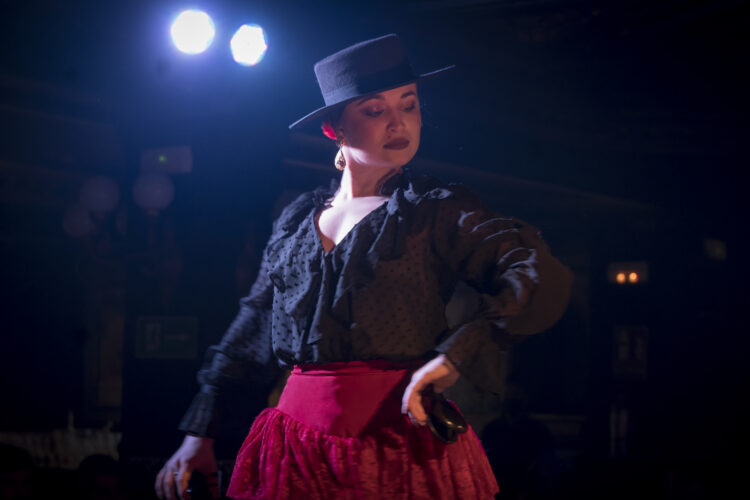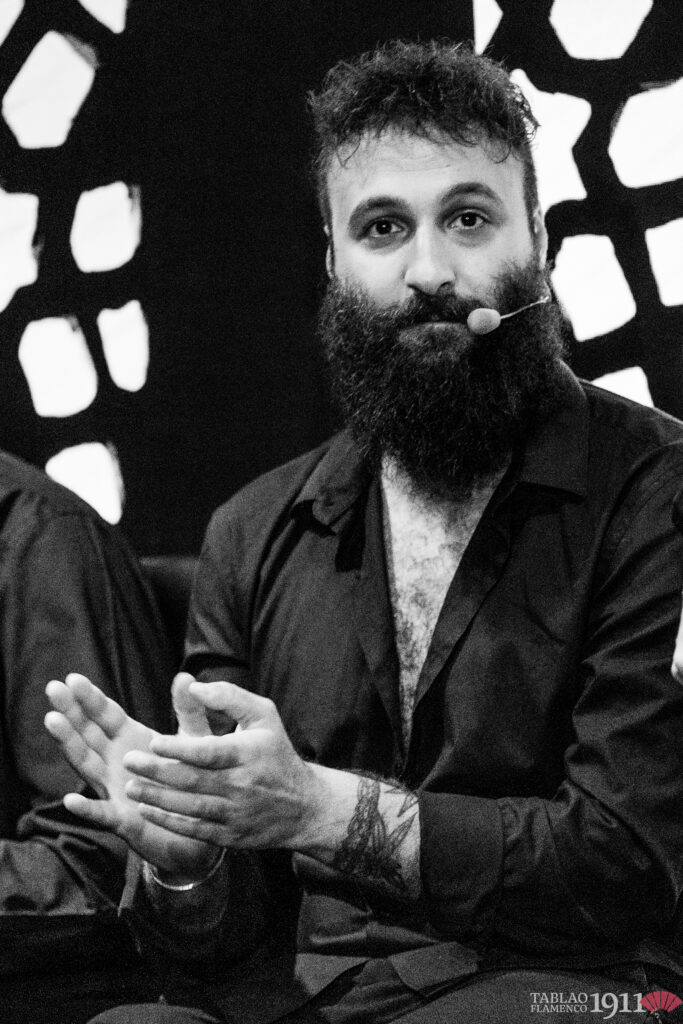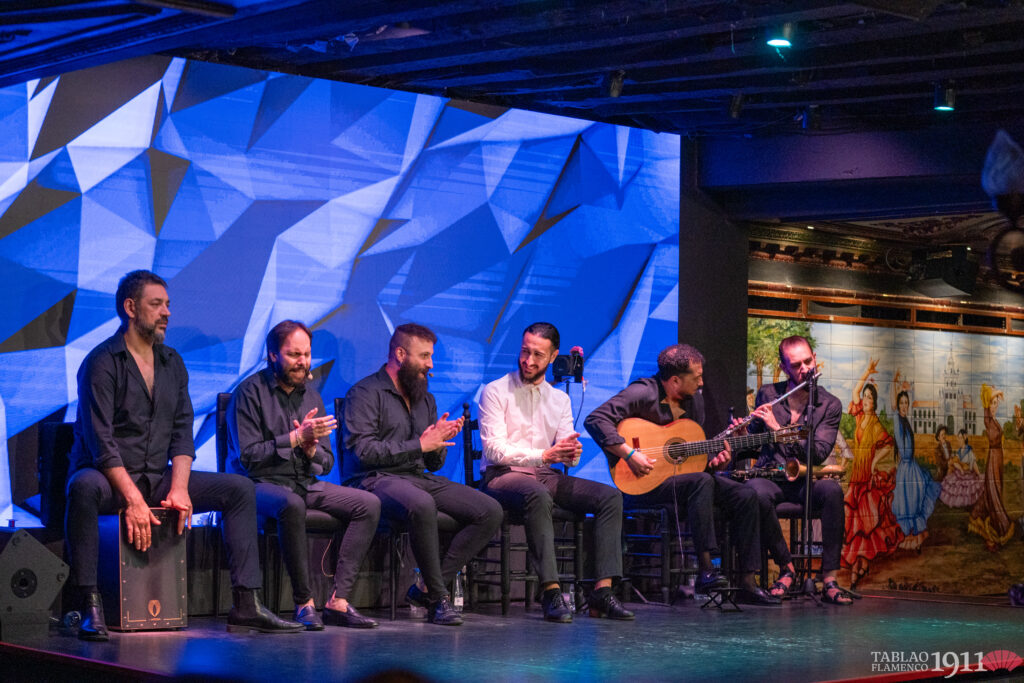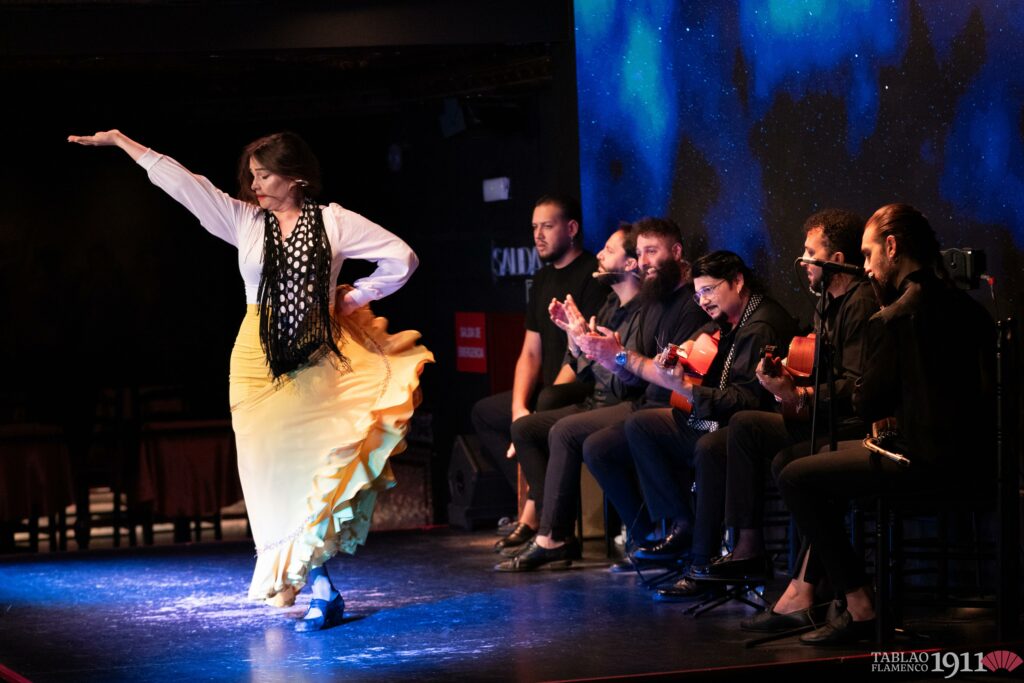
Laura Fúnez and the Escuela Bolera
Escuela Bolera, strength and elegance on stage.

Much has been written about the compás. But theory is one thing, and feeling it come to life in the hands of a master is another. The art of palmeo is the oldest language of this tribe, the heartbeat that connects it all. These flamenco claps are not just applause; they are the rhythmic soul of flamenco.
To talk about this art, we sat down at Tablao 1911 with José del Calli. We set aside his role as an excellent singer to focus on this other discipline he masters like few others: that of an exceptional palmero.
Theory tells us that compás is the architecture of flamenco. But technique without intention is a body without a soul. We’re talking about the intention behind each strike.
José, when you begin to mark the first claps of the night, what are you looking for? Are you thinking about the meter or are you already telling a story with your clapping before even opening your mouth?
«The first thing I look for, like in all art, is to build up gradually — not give everything away from the start.»
His initial goal is not embellishment, but anchoring. He seeks what in flamenco slang is called “the weight.”
«I search for that weight, as we flamencos say, to mark the structure of the compás, so that we’re all held together.»
His claps at that initial moment do not seek protagonism, but rather to become the rhythmic foundation. Their function is to create a firm, shared ground. «Let my claps in this case serve a bit as a base, like a cajón, simply, and well, look for the weight on the first beat so that the style we’re playing settles in that moment.»

The art of flamenco palmas is, above all, an art of nuance. It’s not just about marking rhythm; it’s about painting it with different colors and textures. In this sound palette, two key techniques stand out.
At one end, we find the muted claps (palmas sordas). They are achieved by cupping the hands to create a deep, soft, muffled sound—almost like a rhythmic whisper. These are the claps that wrap the music, that support without intruding. You’ll feel them sustaining the slow, profound compás of a Soleá or in the most delicate moments of the singing.
At the other end are the clear or sharp claps (palmas claras o sonoras). Here, the hands stay firm, producing a crisp, high-pitched sound like a whip. They are pure energy, driving the festive rhythm of Bulerías or Alegrías, highlighting the most intense flourishes of the dance.
But these claps are much more than a metronome. They are a tool of communication among the artists, a musical dialogue that heightens emotion and guides improvisation.
José, theory gives us the map, but you draw the route live. How do you decide which sound to use? Is it a purely technical choice depending on the palo, or rather a visceral response to the energy the dancer gives you in that exact moment?
“It depends on the moment, on the situation, on the palo, on the dancer, on the singer who is performing, and at that moment I have to accompany, on the guitar…”
His choice is not solitary; it is a constant response to stimuli. He mentions whether the guitarist is in a falseta, and whether to use an open or muted clap, making clear there is no fixed rule. “It depends on many situations,” he sums up.
But mastery goes beyond choosing between open and muted. It lies in mixing them, playing with the color to create unexpected textures.
“You can even play with different color — that is, go from muted to open. Even if the dancer is doing a heel (tacón) and you need a muted clap, you can still play, knowing how to, by occasionally inserting an open clap to subtly shift the color, even if the base is muted.”
This is where the palmero becomes a painter, adding strokes of light over a dark canvas, showing that his art is not about following rules, but knowing when and how to break them with intention.
Palmeo isn’t just about following – it’s also about challenging. Syncopation is one of the most advanced and exhilarating techniques, a leap into the void that requires absolute trust.
What do you need to feel from your companions to dare to break the structure and play with those silences? What does that vertigo bring to the performance?
“What I need to feel from my companions, first, is that they have a solid base and that we’re anchored to that base to be able to do syncopation.”
“There are times when I haven’t had a good base, and the claps are useless. I end up doing very soft claps, as I say, and I can’t enhance the dancer or the artist on stage at that moment, because it’s just not possible.”
Syncopation, then, is not just a rhythmic ornament – it’s the sign of a perfectly functioning flamenco cuadro, a mark of connection between the artists. Only when José feels that security can he unfold his full artistry.
“I need a strong and steady base, and with that rhythm in place, I can give everything I have and everything I am.”
The arsenal of a palmero of your caliber doesn’t stop at your hands. Jaleo — those “¡Olé!”, “¡Vamos allá!”, “¡Agua!” — is also percussion, another form of vocal palmeo.
An offbeat jaleo can kill the inspiration, but a well-timed one can lift an artist to glory. What’s the secret to a good jaleo for you? Is it more about what is said, or the exact moment it’s shouted, like another clap?
“For me, jaleo is a euphoric state that comes out when a dancer, a singer, a guitarist, a percussionist, someone on stage pulls something out of you. It makes you feel the urge to throw it at them like a compliment.”
“It’s not about what you say, the word. Like, ‘olé’ doesn’t mean the word itself is beautiful. I often do it with a sound, and say ‘¡ah!’ or ‘¡agua!’ or whatever, something like that. It’s not ‘olé’ because it’s a pretty word.”
Jaleo is a visceral impulse, a sound that bursts out unfiltered. It’s proof that the other person’s art has struck something deep within you. As he says, it’s “something that moves you, something that called from inside you, I don’t know what, that inspires you to move that way, to feel that sensation.”
It’s not a decision. It’s a consequence.

And this brings us to one of the deepest praises in flamenco. It is said of you that you are a “bailaor sentao.” We know that it is not only because of the mastery of your flamenco claps, but also because you tap from the chair.
José, having the ability to sing, clap, and tap at the same time is quite a feat. How do you manage that kind of bodily dissociation? Is it something you train consciously or a wisdom that the flamenco body acquires after thousands of nights on stage?
“I wouldn’t say it’s something you train, honestly. Although it’s very relative too, because it could be considered training, since I’ve grown up in a house full of flamencos. My parents, all artists, my uncles… I grew up there and would fall asleep listening to live singing.”
That ability wasn’t born in a classroom but in the heart of a flamenco home, in a family tablao. It wasn’t a decision, it was a natural development. The tapping from the chair, therefore, isn’t an added technique, but an extension of a passion for dance.
“I really like dancing too. And since I love dancing and playing with rhythms and timing, I guess I learned it the hard way, right?”
The dissociation isn’t a mental exercise; it’s the result of a life immersed in rhythm. It’s not something he practiced in isolation. “It’s not like I trained alone at home saying ‘okay, this beat, now this tap’—no. It’s something that just comes out, I don’t know how to explain it, it’s something innate.”
That wisdom, as he says, comes out “by force,” born from something within, from a body that learned to feel and express rhythm in every possible way, even from a chair.
Clapping doesn’t exist in a vacuum; it’s a constant dialogue. The guitar proposes falsetas, moments of calm or virtuosity that the palmero must know how to support.
How is that dialogue with the guitarist? When he starts with a falseta, do your claps back off to give him space or do they transform to create a rhythmic base he can fly safely over?
“When the guitarist starts a falseta, you have to provide a good base and accompany him well with a good soniquete, as we call it.”
The goal is to create a rhythmic cushion, a firm floor where the guitarist can freely develop his melody. However, this accompaniment is not passive. The palmero stays alert, waiting for the right moment to come in with more force and join the climax.
“You can strike at the end of the falseta. And if you see it coming, you attack in the best way possible, playing and counterpointing, and he plays with you too.”
It’s a game of complicity. The palmero supports, and right at the end, in the climax, he launches alongside the guitarist to close the musical drawing in a shared explosion. “And that’s when the ‘olé’ comes too,” he says.

This level of knowledge in the art of palmeo seems like a secret language, a heritage passed from master to student in the intimacy of the tablao.
Is this deep knowledge you have as a palmero something that can be taught in a classroom, with a blackboard, or is it a wisdom that can only be transmitted night after night, breathing the same air as your companions on stage?
“Sure, teaching, explaining—of course you can teach the technique, I think so. The technique, yes, and the doubles that are made, the contratiempos, sure you can.”
However, the real challenge, what I consider difficult to convey in a classroom, is the very essence of flamenco rhythm.
“What’s really hard to teach is the compás. Compás, I think, is innate. You can improve it over time and have a better compás, but it will always be a learned compás.”
This is where the crucial difference lies: a compás “learned” versus an “innate” one. It’s not the same to perform it as to carry it within. “It’s not like wearing it as a coat,” he says. José admits that this natural gift can be good or bad from birth, but it’s the starting point that defines everything.
For those born with it, “every time they grow more and more, their compás gains form and they reach enormous levels.” But for those who start with a weaker base, their progress has a ceiling. “If your compás is too low, you’ll always stay stuck there. You’ll stay at a low level. Yes, okay, but not really.”
Ultimately, technique can be taught, but compás—that deep heartbeat—is something that must be lived.
Finally, for such a subtle and nuanced palmeo to be appreciated, a proper ecosystem is needed, even in styles like Tangos or Fandangos that call for celebration.
For all this language of flamenco clapping, footwork, and glances to work, how important is a space like this—an intimate tablao where you can feel even your partner’s breath and where the audience comes to listen, not just to watch?
“What comes out of the musician, the artist, is unrepeatable in that moment.”
That is the magic that cannot be planned. José contrasts it with the stiffness of large productions, where spontaneity is sacrificed.
“There are many great days when things happen that didn’t even happen during three months of rehearsal at the Teatro Real with the same people.”
The tablao is fertile ground for the unpredictable. It’s a place that summons the duende. “In a tablao, things come out that are magical, that are unrepeatable.” And that magic, he says, multiplies when the environment and fellow artists rise to the occasion.
“And the truth is, a tablao—talking about 1911, with so many top-tier artists—is where the extraordinary is more likely to happen.”
The tablao, therefore, is not just a stage, it’s an active ingredient, a catalyst which, combined with first-class artists, guarantees that the extraordinary is not an exception but a habit.
After a conversation like this, you can’t hear palmas the same way. You understand that palmeo is not just rhythm, it’s a narrative; it’s not applause, it’s dialogue. And that to dance, sometimes the greatest wisdom is to remain seated.
Come listen to the dialogue. Reserve your night in the heart of flamenco.